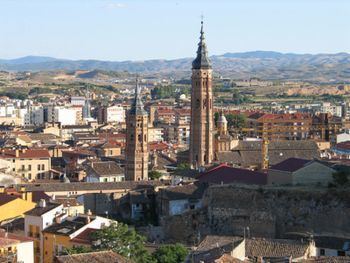Judicial district Calatayud Area 154 km² Local time Monday 10:43 AM | Autonomous community Aragón Comarca Comunidad de Calatayud Elevation 530 m (1,740 ft) Population 20,658 (2014) Team Atlético Calatayud | |
 | ||
Weather 14°C, Wind W at 19 km/h, 68% Humidity Points of interest Iglesia de San Juan el Real, Colegiata de Santa Maria la, Museo de Calatayud, Plaza España | ||
Calatayud (Aragonese: Calatayú; 2014 pop. 20,658, declining during the last decade due to migration) is a municipality in the Province of Zaragoza, within Aragón, Spain, lying on the river Jalón, in the midst of the Sistema Ibérico mountain range. It is the second-largest town in the province after the capital, Zaragoza, and the largest town in Aragón other than the three provincial capitals. It is the seat of the comarca of Calatayud.
Contents
- Map of Calatayud Zaragoza Spain
- Highways and railways
- History
- Main sights
- Quarters and villages
- Fiestas
- Traditions
- Sister City
- References
Map of Calatayud, Zaragoza, Spain
The city has the title Muy noble, leal, siempre augusta y fidelísima ciudad de Calatayud ("The very noble, loyal, always august and most faithful City of Calatayud"). The first democratic elections after General Franco's regime were called for 15 June 1977. In Calatayud they were held one day earlier than all the rest of Spain, in order to prepare for a visit there by King Juan Carlos I.
Highways and railways
The town is located by the Carretera Nacional N-II highway, the Autovía A-2 and the N-234, among other local roads.
The AVE Madrid–Barcelona high-speed rail line, as well as the RENFE line from Madrid to Barcelona stop in Calatayud.
History
The city was founded on the site of a Celt-Iberian settlement by the Romans with the name Augusta Bilbilis and was the birthplace of the poet Martial in 40 CE. The site of the ruins of Augusta Bilbilis are approximately four kilometers to the north of the modern city of Calatayud. The modern town was founded by the Moors around the Ayyub castle, circa 716 CE.
The name Calatayud came from the Arabic Qalat 'Ayyūb = "Ayyub's castle" (Ayyub is a fairly common Arabic given name). The ancient inhabitants of Bilbilis moved to the new site. Occupying a strategic placement between the central meseta of Spain and the Ebro valley the city retained its importance in succeeding centuries. By the eleventh century a substantial Jewish community was present, surviving the reconquista until the expulsion of the Jews from Spain in 1492. The city was conquered from the Muslims by Alfonso I of Aragón in 1119. Many surviving examples of mudéjar church architecture show that the Moorish influence lived on.
During the Peninsular Wars a notable siege of French occupied Calatayud led to its capture by guerillas in 1811. The city was the capital of its own province in 1822–23, during the Trieno Liberal.
The town suffers from sinkholes.
Main sights
One of the most notable Mudéjar towers of Aragón is the 15th-century bell tower of the collegiate church of Santa María, which was built on the site of a mosque. The Muslim fortress is the biggest and oldest one on the Iberian peninsula. The church of "San Pedro" was founded by Ferdinand II of Aragón and it was there that the first cortes (parliament) of Aragon was held in 1411.
Quarters and villages
Fiestas
Traditions
There is a popular Spanish song that says (translated) "If you go to Calatayud / ask for Dolores (a popular female name) / she is a very nice girl / fond of make favours" that captures the (traditional) fame of girls in Calatayud. Given that reputation, traditionally boys went to the town in order to "ask for Dolores" to be "favoured" by local girls. Nowadays this tradition has dismissed although in festivities, boys from the surroundings, even from Zaragoza, visit the town with that aim.
Sister City
Calatayud has one sister city.:
